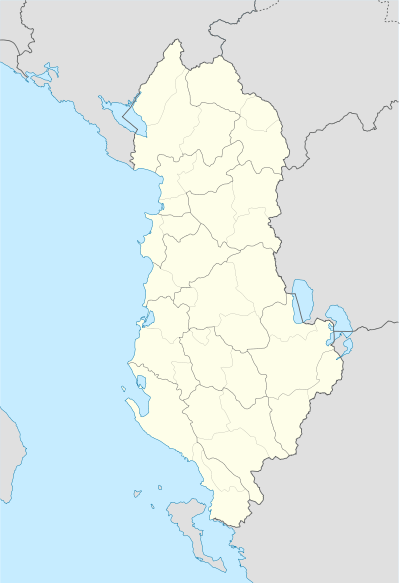Pogon, Albania
| Pogon | |
|---|---|
| Administrative Unit | |
 Pogon | |
| Coordinates: 40°8′N 20°21′E / 40.133°N 20.350°ECoordinates: 40°8′N 20°21′E / 40.133°N 20.350°E | |
| Country |
|
| County | Gjirokastër |
| Municipality | Dropull |
| Area | |
| • Total | 177.6 km2 (68.6 sq mi) |
| Population (2011) | |
| • Administrative Unit | 432 |
| Time zone | CET (UTC+1) |
| • Summer (DST) | CEST (UTC+2) |
| Vehicle registration | GJ |
Pogon (Greek: Κάτω Πωγώνι, Kato Pogoni) is a former municipality in the Gjirokastër County, southern Albania. At the 2015 local government reform it became a subdivision of the municipality Dropull.[1] The population at the 2011 census was 432.[2] It consists of seven villages: Poliçan, Skore, Hllomo, Sopik, Mavrojer, Çatistë and Selckë, of which Poliçan is the administrative center.[3]
Geography
Greek is widely spoken in the villages.[4] Selckë, part of a wider region of Lunxhëria, is mainly inhabited by an Albanian population as well as later Aromanian migrants, while the rest of the towns belong to the Greek minority zone.[5]
History
In 15th century Pogon came under Ottoman rule and became part of the Sanjak of Ioannina.[6] It was a nahiya centre as "Pogun" at Pogun kaza (Its centre was Voştina) in Ergiri sanjak of Yanya Vilayet till 1912. As part of Albania, the municipality is part of the recognized Greek Minority Zone.[7]
Historically each village of Pogon has its own variation of traditional costumes and dresses.[4] The area is part of Pogoni, a region that also includes parts of nearby Pogoni on the Greek side of the border.
Culture
The villages of Pogon (except Selckë) are part of the wider Pogoni region, which is divided between Greece (40 villages) and Albania (7 villages).[8][9] Polyphonic singing, although shared among several ethnic groups, tends to be mostly identified with the Pogoni area.[8]
Notable people
- Sophianos (-1711), local Greek-Orthodox bishop and scholar.
- Pandeli Sotiri, Albanian patriot, main contributor to the modern Albanian alphabet
References
- ↑ Law nr. 115/2014
- ↑ 2011 census results
- ↑ Greece – Albania Neighbourhood Programme
- 1 2 Hammond Nicholas Geoffrey Lemprière. Epirus: the geography, the ancient remains, the history and topography of Epirus and adjacent areas. Clarendon P., 1967, p. 29
- ↑ Malo, Foto, Emra vendesh në krahinën e Lunxhërisë (Toponyms in Lunxhëri region) (in Albanian), Tribuna, retrieved 2013-08-29
- ↑ H. Karpat, Kemal (1985). Ottoman population, 1830-1914: demographic and social characteristics. p. 146. Retrieved 22 September 2011.
- ↑ Green, Sarah F. (2005). Notes from the Balkans : locating marginality and ambiguity on the Greek-Albanian border. Princeton, NJ [u.a.]: Princeton Univ. Press. ISBN 978-0-691-12198-7.
- 1 2 Tziovas, edited by Dimitris (2003). Greece and the Balkans : identities, perceptions and cultural encounters since the Enlightenment. Aldershot, England: Ashgate. p. 196. ISBN 9780754609988.
Although it characterizes many local communities and ethnic groups, such as Vlach and Albanian speakers, it tends to be mostly identified with the Pogoni area, which, ironically enough, is divided between Greece and Albania, seven villages belonging to the latter. Of the rest, about forty villages belong to Greece)
- ↑ Hammond, 1967, p. 213
Further reading
- ΖΩΤΟΥ, ΜΕΝΕΛΑΟΥ; ΓΙΑΝΝΑΡΟΥ, ΧΡΙΣΤΟΦΟΡΟΥ. Η ΠΟΛΥΤΣΑΝΗ ΤΗΣ ΒΟΡΕΙΟΥ ΗΠΕΙΡΟΥ. ΕΚΔΟΣΕΙΣ, ΙΩΑΝΝΙΝΑ, 1989. (Greek)
- Politsanitika Nea Newspaper, Tel. +30 210 5238058 (Greek)

